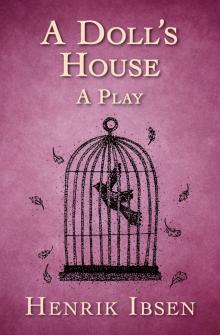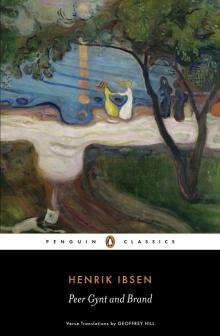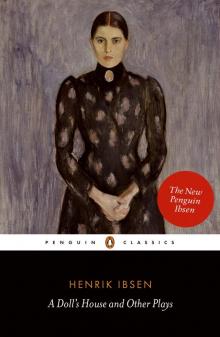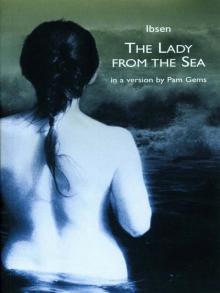- Home
- Henrik Ibsen
The Master Builder and Other Plays Page 2
The Master Builder and Other Plays Read online
Page 2
1897 World premiere of John Gabriel Borkman at the Svenska Teatern (Swedish Theatre) and the Suomalainen Teaatteri (Finnish Theatre) on 10 January, both in Helsinki.
1898 Gyldendal in Copenhagen publishes a People’s Edition of Ibsen’s collected works.
Ibsen’s seventieth birthday is celebrated in Kristiania, Copenhagen and Stockholm, and he receives greetings from all over Europe and North America.
1899 Når vi døde vågner (When We Dead Awaken), his last play, is published in 12,000 copies on 22 December.
1900 When We Dead Awaken is performed at the Hoftheater in Stuttgart on 26 January.
C. H. Herford translates Love’s Comedy; William Archer translates When We Dead Awaken.
Ibsen suffers a first stroke in March, and his health deteriorates over the next few years.
James Joyce’s ‘Ibsen’s New Drama’ appears in The Fortnightly Review in April.
1903 Imperial Theatre, London, produces When We Dead Awaken on 25 January and The Vikings at Helgeland on 15 April.
1906 On 23 May Henrik Ibsen dies in his home in Arbins gate 1 in Kristiania.
The Collected Works of Henrik Ibsen, translated and edited by William Archer, appears in twelve volumes over the next two years.
A Note on the Translation
In a letter of 1872 Henrik Ibsen himself summed up the challenges for the literary translator: ‘To translate well,’ he wrote, ‘is a difficult matter. It is not simply a question of translating the meaning but also, to a certain extent, of re-creating the style and the images and ultimately of adapting the entire form of expression to the structure and demands of the language into which one is translating.’1 It is a daunting remit: to provide English texts that both trust the letter and spirit of Ibsen’s drama and seek to bring out as much of their original linguistic, cultural and historical complexity and nuance as possible. This means always keeping an eye on the overall structure, while remaining true to the micro level of language, in order to convey the necessary weight, rhythm and tension in the dialogue.
The four plays in this volume, the last Ibsen was to write, register a shift in vision and technique. Figures such as the Rat-Maid and Irene tend to resist definition by realist measures, while individuals such as Solness and Borkman are entrenched in their own myths. The dialogue becomes increasingly poetic, enacting the mythopoeia of castles, trolls, forests, mines and mountains, while the scenic space shifts from the stuffy interiors that suffocate Erhart Borkman to the outdoor spaces. There is an inexorable outward progression beginning in The Master Builder and culminating in When We Dead Awaken, set exclusively outside and ending on a cold mountain plateau with a Latin benediction. At the same time, Ibsen continues to develop his stage directions, making them increasingly nuanced and novelistic.
Translating Ibsen is not, therefore, limited to a re-creation of ‘the style and images’. Each play has its own distinct storyworld, shaped by its setting, its characters and their language. This, too, must be credibly and faithfully rendered; each possesses its own voice or tone, just as each character has his or her own linguistic idiosyncrasies which the translator must endeavour to replicate. In The Master Builder, for example, Hilde Wangel’s breezy, forthright manner acts as a counterpoint to Solness’s reluctance to say things straight out; her often effusive language, the repeated use of such words and phrases as ‘terribly splendid’, ‘glorious’, ‘wonderfully exciting’, contrasts sharply with Kaja’s meekness and Aline’s at times querulous, at times resigned tone. When We Dead Awaken similarly produces many tensions in register: Rubek’s struggle with his identity as an artist; the self-important spa manager; the coarse sexual menace of Ulfheim; the elusive abstractions of Irene; Maja’s pragmatism and the Sister of Mercy’s closing benediction.
While rooted in the quotidian, Ibsen’s dialogue in these plays is subtle, poetic and often symbolic, his approach to language fresh and innovative. He frequently coined his own words and phrases, which, like all neologisms, sounded odd in his Dano-Norwegian of the 1890s,2 although some of them have now been absorbed into modern Norwegian. One example of this is Borkman’s overskurk, here translated as ‘übervillain’, a formulation as self-conscious as the original. Rather than smooth over such quirks with bland, clichéd renderings, the translator must allow what Inga-Stina Ewbank calls Ibsen’s ‘inalienable strangeness’ to speak for itself.3 And although the aim is to transpose these plays into a natural modern English, we have resisted formulations that are so colloquial that they will quickly become dated.
Such is the precision and economy of Ibsen’s language that the translator is often presented with the challenges inherent in translating poetry. He saw his entire dramatic oeuvre, particularly the twelve plays beginning with Pillars of the Community, as a cycle. Recurring themes and key words run through them like threads, keeping them poised in constant dialogue with each other. Frequently, these words are taken from the lexicon of ordinary language, foregrounded and made extraordinary through repetition and modulation. Concepts such as glæde (joy), plikt (duty), skyld (guilt) and gæld (debt) run through the corpus and reveal Ibsen’s developing philosophy of the key coordinates of human life. We have tried to render this development as consistently as possible.
Characters repeat words and phrases of profound personal importance, as well as picking up words used by others and investing them with their own significance. The result is a remarkably coherent storyworld, in which the characters structure something approaching not only an idiolect, but often an entire personal philosophy and mythology around key words such as lykke (happiness).
John Gabriel Borkman is a case in point. When undertaking the first English translation in 1897, William Archer argued that the greatest difficulty was to find a happy English equivalent for the word oprejsning, which can be rendered variously as ‘restitution’, ‘restoration’, ‘rehabilitation’, ‘amends’ and ‘redemption’. The verb oprejse can mean anything from ‘to erect’ to ‘to raise from the dead’. Through repetition Ibsen exposes, in an unlaboured manner, how each character’s understanding of oprejsning, the meanings they derive from it as well as invest in it, reveals their preoccupations and vision. For Gunhild, the material and social dimension is paramount; Foldal understands it as a legal obstacle, while Erhart refuses to be drawn into any narrative constructed around it. Borkman, despite the fact that his vision remains determinedly solipsistic and secular, plunders both the social and material dimension of the word as well as its religious overtones of atonement and redemption, in much the same way that he yearns to extract metal ore from deep inside the mountains.
There are, of course, instances where dogged adherence to the principle of consistency is ill advised and context has to be the deciding factor, sometimes in order to avoid contrived formulations, and sometimes because the context determines another primary connotation of a word in English. In Little Eyolf, while ond, in many instances, has to translate as ‘evil’ to tie in with the image of the ‘evil eyes’, in Rita’s and Allmers’s recurring discussion of onde and of becoming onde og stygge (ugly), ‘evil’ strikes a wrong note. In this context ‘wicked’ was deemed the better, less metaphysical alternative.
Apart from the difficulties presented by discrete words and concepts, the translator should also aim at preserving the physicality of the plays, communicated through both dialogue and stage directions. Through these means Ibsen pinpoints the precise position of his characters: seated, standing or walking around, moving towards or away from something or someone. One of the ways he achieves this is by using constructions common in his Dano-Norwegian, such as sidde (sit), stå (stand) and gå (‘go’ or ‘walk’) in combination with other verbs, whereas in English, ‘standing looking’ or ‘sat and thought’ are not obvious formulations. In order to preserve this, we have sometimes opted for a more literal wording than might otherwise have been chosen. For example, at the beginning of Act Two of Little Eyolf Allmers is sitting on a bench gazing at the fjord. Three times within the
first few lines Asta refers to the fact that he is ‘sitting’ there: ‘Du skulde ikke sidde her ned i gråvejret, Alfred’ (‘You shouldn’t be sitting down here in this grey weather, Alfred’), she says. And then: ‘Har du siddet længe her nede?’ (‘Have you been sitting down here long?’). Further down this is then followed by: ‘Å, Alfred, sid ikke og stir ud på den fjorden!’ (‘Oh, Alfred, don’t sit there staring at that fjord!’). In all three cases it would be quite possible to omit the word ‘sit’ in translation. But the image of the grief-stricken father who can do nothing but sit there, gazing at the waters that have stolen his son, is continually reinforced by Ibsen.
On Ibsen’s stage, the relative social positions of the characters are clearly established through different forms of address – formal and informal. In nineteenth-century Norway these were rigidly adhered to, the informal, singular personal pronouns du and dig being used only with family and intimate friends. In all other cases, the formal, plural De and Dem forms were used. Such distinctions are lost in English, but since in Ibsen modes of address tell us something about social, professional and personal relationships, they cannot simply be ignored in translation. In When We Dead Awaken even the venal, menacing Ulfheim, alone on the mountain with Rubek’s wife, is careful to use the polite form when he threatens to tie her up with a dog leash. The translator has therefore to find other ways of reflecting particular modes of address: by using the name or title of the person addressed (‘doctor’, for example) or occasionally by the use of ‘sir’ or ‘ma’am’.
Ibsen’s women frequently address and refer to their husbands and other male characters by surname, a nineteenth-century Norwegian convention that does not have the distancing effect it does in English. It seemed advisable either to use the Christian name, in the case of a spouse, or to add ‘Mr’ where necessary. The same problem arises with the custom of addressing people by their professional, trade or academic titles. Because English makes much less use of names in direct address than Norwegian, the insistence on professional attribute as well as name is jarring and only creates a distraction for the reader. We have therefore opted to use these designations only for the purpose of establishing identities, unless a particular tone is desired or a wider point has to be made.
Few things are quite straightforward in Ibsen, and this is also true on the stylistic level. The dialogue is frequently qualified by common Norwegian modal particles such as da, vel, jo, visst and nok, subtle modifiers whose function may in part be covered by English wordings such as ‘oh’, ‘well’, ‘why’, ‘surely’ or ‘of course’, depending on context. Sometimes they are not directly translated at all, but their sense is woven into correspondingly colloquial and natural-sounding English formulations instead. These ‘fillers’ give the lines their flow and rhythm; they colour remarks and statements, setting their tone, giving them lightness or weight. When Hilde makes her entrance in The Master Builder her speech is positively bouncing with vels and das, a jaunty directness which stands in contrast to Solness’s initially stiff and reserved responses. In the mouths of other characters, however, these and other modifiers can express hesitancy or assertiveness, resignation or resolve. So the translator continually has to ask: who is speaking here? What exactly is being communicated?
Common to all translators of classic literary texts is a sense of indebtedness to previous translators. And if ever translators had occasion to feel the anxiety of influence, it is in translating Ibsen. William Archer, Michael Meyer, Rolf Fjelde, James McFarlane, Una Ellis-Fermor, Peter Watts and Inga Stina-Ewbank constitute an illustrious yet incomplete list. Ibsen himself deplored the idea of language as an obstacle between his writing and the English-speaking world. In a letter to Edmund Gosse in 1872 he wrote: ‘The English are so close to us Scandinavians in spirit, in their way of thinking, and in their emotional life, and precisely for this reason it has been painful for me to think that the language should put up a barrier between my writing and all this great, kindred world.’4 We hope that with these new translations of Ibsen’s last four plays we have also played our part in breaking down the barrier between the greatest dramatist of the nineteenth century and the English-speaking reader of the twenty-first century.
Barbara J. Haveland
Anne-Marie Stanton-Ife, 2014
Notes
1. Letter to Fredrik Gjertsen, 21 March 1872, in Narve Fulsås, ed., Henrik Ibsens Skrifter, vol 13: Brev (1871–1879) (Oslo: Aschehoug, 2008), p. 52.
2. Danish was the official written language of Norway under Danish rule (1563–1814) and continued to be throughout the nineteenth century, despite the growing force of native Norwegian language movements. Ibsen’s Danish is characterized by its many ‘Norwegianisms’.
3. Inga-Stina Ewbank, ‘Henrik Ibsen: National Language and International Drama’, in Bjørn Hemmer and Vigdis Ystad, eds., Contemporary Approaches to Ibsen, vol. 6 (Oslo: Norwegian University Press, 1988), p. 65.
4. Letter to Gosse, 2 April 1872, in Fulsås, ed., Henrik Ibsens Skrifter, p. 56.
A Note on the Text
This Penguin edition is the first English-language edition based on the new historical-critical edition of Henrik Ibsen’s work, Henrik Ibsens Skrifter (2005–10) (HIS). The digital edition (HISe) is available at http://www.ibsen.uio.no/forside.xhtml. The texts of HIS are based on Ibsen’s first editions.
Introduction
Ibsen’s Late Style
In 1891, at the age of sixty-three, Henrik Ibsen returned to Norway after twenty-seven years in Italy and Germany. He had left Christiania (now Oslo) for Rome as a vigorous young writer in the prime of life; he returned as a world-famous dramatist entering into old age. After the move, Ibsen continued to publish a play every other year. Of the last four plays, The Master Builder appeared in 1892, Little Eyolf in 1894 and John Gabriel Borkman in 1896. In 1898 Ibsen was too busy to write a new play. He turned seventy in March and participated in extensive birthday celebrations all over Scandinavia. At the same time he was preparing the first edition of his collected works in both Danish and German.1 By February 1899, however, he was working on his next play, which appeared in December. The following year Ibsen suffered two strokes, from which he never recovered. When We Dead Awaken, with its prescient subtitle ‘A Dramatic Epilogue’, became his last play.
As Ibsen returned to Kristiania (as it was now written, after the Norwegian spelling review of 1877), he was already one of Europe’s most controversial playwrights. His plays were widely performed in Scandinavia and Germany and had begun to make their way in Britain and France. In the 1890s, however, Ibsen’s plays exploded on to the stage all over Europe. In Scandinavia, every new Ibsen play had long been a publishing sensation, but even there, readers’ interest peaked in the 1890s: in December 1896, the whole first printing of 12,000 copies of John Gabriel Borkman sold out so fast that a second printing of 3,000 copies had to be ordered before the first had even reached the booksellers.2 In the 1890s, European-wide translations appeared within a few weeks. The Danish first edition of The Master Builder included a note informing readers that authorized translations into English, German and French were appearing ‘almost simultaneously’, to be followed ‘somewhat later’ by translations into Russian, Dutch, Hungarian, Czech and Polish.3
European theatres competed for the rights to produce the latest Ibsen play as soon as possible after publication. The Master Builder, for example, was published on 12 December 1892.4 Just one month later, on 19 January 1893, the world premiere took place at the Lessingtheater in Berlin. By the end of May, the play had also been performed in Trondheim, Leipzig, London, Helsinki, Kristiania, Copenhagen, Rome, Gothenburg and Turin.5 Little Eyolf, published in December 1894, had an even faster international trajectory: by the end of May 1895, it had opened in eighteen different theatres, not just in Kristiania, Copenhagen, Berlin and London, but also in cities such as Helsinki, Amsterdam, Milan, Paris and Boston. The enthusiasm for When We Dead Awaken, which opened in twelve different European theatres in the spring of
1900, was less intense, but still striking.
The 1890s: Ibsen’s Theatrical Power Revealed
The 1890s were an unusually complex period in the history of literature, theatre and the other arts, a decade in which old aesthetic dividing lines were dissolving, while new ones were not yet firmly in place. Alongside older movements, a bewildering array of new ‘isms’ were thriving: thus symbolism, decadence, vitalism, aestheticism, impressionism, neo-Romanticism, verismo, realism and naturalism all flourished in the 1890s. In the theatre, Ibsen’s Swedish rival, August Strindberg, remained ferociously productive, and playwrights as different as Maurice Maeterlinck, Oscar Wilde, Anton Chekhov and Gerhart Hauptmann all achieved their dramatic breakthrough in the 1890s.
The aesthetic diversity of the 1890s proved that Ibsen was a gift to actors, regardless of their performance style. In this decade, his plays were taken up by actors and directors of vastly different aesthetic persuasions. Henry James, who attended some of the London rehearsals of The Master Builder in 1893, noted that Ibsen’s ‘strangely inscrutable art’ was peculiarly attractive to actors: ‘What is incontestable is the excitement, the amusement, the inspiration of dealing with material so solid and so fresh.’6 By the end of the decade, it was clear that Ibsen could be successfully performed in any style, and in every kind of theatre, from the extreme avant-garde to the most established institutional theatres.
Ibsen’s breakthrough in France exemplifies this aesthetic diversity. While scholars have long had a tendency to align the French reception of Ibsen with symbolism, Kristen Shepherd-Barr has shown that French Ibsen productions in the 1890s were in fact quite varied, ranging from Théâtre Antoine’s naturalist production of Ghosts in 1890 to the popular actress Gabrielle Réjane’s success with A Doll’s House at a Paris variety theatre in 1894.7 Symbolism was nevertheless important. At the Théâtre de l’Oeuvre in Paris, Aurélien Lugné-Poë produced highly experimental, symbolist versions of Maeterlinck’s and Ibsen’s plays, in which the characters appeared as ethereal shadows and spoke in monotonous sing-song tones.8 (In 1896, Chekhov satirized this specific theatrical style in The Seagull.) Lugné-Poë also toured Europe with these productions. In October 1894, his company visited Kristiania with Ibsen’s Rosmersholm and The Master Builder, and Maeterlinck’s Pelléas and Mélisande.9 Ibsen, who turned up to see his own plays, apparently told the Danish writer Herman Bang that the symbolists’ production of The Master Builder was ‘the resurrection of my piece’.10

 A Doll's House
A Doll's House Peer Gynt and Brand
Peer Gynt and Brand The Master Builder and Other Plays
The Master Builder and Other Plays A Doll's House and Other Plays (Penguin)
A Doll's House and Other Plays (Penguin) The Lady from the Sea
The Lady from the Sea